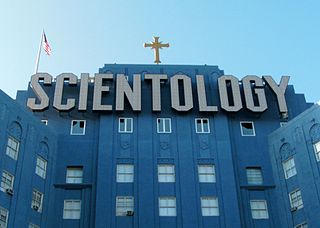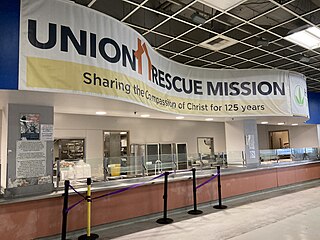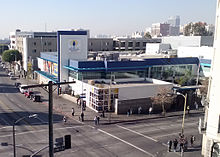
A skid row, also called skid road, is an impoverished area, typically urban, in English-speaking North America whose inhabitants are mostly poor people "on the skids". This specifically refers to people who are poor or homeless, considered disreputable, downtrodden or forgotten by society. A skid row may be anything from an impoverished urban district to a red-light district to a gathering area for people experiencing homelessness or drug addiction. In general, skid row areas are inhabited or frequented by impoverished individuals and also people who are addicted to drugs. Urban areas considered skid rows are marked by high vagrancy, dilapidated buildings, and drug dens, as well as other features of urban blight. Used figuratively, the phrase may indicate the state of a poor person's life.
Mission Australia is a national Christian charity that provides a range of community services throughout Australia. It has its roots in the Brisbane sector of The British and Foreign Bible Society’s sub-committee, The Colporteur Society (1869), and Sydney City Mission (1862), but was only officially established in 1996, bringing together a number of city missions across the country. The organisation specialises in the areas of homelessness and housing, families and children, early learning, youth, employment and skills, substance abuse, disability, mental health, and strengthening communities. Sharon Callister has been CEO since March 2022.

Skid Row is a neighborhood in Downtown Los Angeles. The area is officially known as Central City East.
The Venice Community Housing Corporation (VCHC) was formed in 1988 by a group of grassroots activists who were interested in preserving affordable housing in the Venice neighborhood of Los Angeles, California, United States. Since that time, VCHC has grown to a comprehensive community development corporation with family support programs, gang prevention programs, job training and affordable housing.

Visual Communications –– is a community-based non-profit media arts organization based in Los Angeles. It was founded in 1970 by independent filmmakers Robert Nakamura, Alan Ohashi, Eddie Wong, and Duane Kubo, who were students of EthnoCommunications, an alternative film school at University of California, Los Angeles. The mission of VC is to "promote intercultural understanding through the creation, presentation, preservation and support of media works by and about Asian Pacific Americans."
The Cathedral Shelter of Chicago was founded in 1915. It began as a storefront mission of the Episcopal Diocese of Chicago, attached to the former Cathedral of Sts. Peter and Paul, providing food and clothing to the poor and homeless. In 1920, they began offering substance abuse treatment. Under the leadership of Father David Gibson, an Episcopal priest, the shelter was of great importance during the Great Depression.
The Zen Peacemakers is a diverse network of socially engaged Buddhists, currently including the formal structures of the Zen Peacemakers International, the Zen Peacemaker Order and the Zen Peacemaker Circles, many affiliated individuals and groups, and communities formed by Dharma Successors of Roshi Bernie Glassman. It was founded by Bernie Glassman and his second wife Sandra Jishu Holmes in 1996, as a means of continuing the work begun with the Greyston Foundation in 1980 of expanding Zen practice into larger spheres of influence such as social services, business and ecology but with a greater emphasis on peace work. Eve Marko, Bernie Glassman's third wife, is a founding teacher of the Zen Peacemaker Order. Zen Peacemakers have developed from the White Plum Asanga lineage of Taizan Maezumi.

The Clara White Mission (CWM) is a non-profit organization in Jacksonville, Florida, USA, founded by Dr. Eartha M. M. White that advocates for the poor and provides social services. According to its website, "The Clara White Mission is to reduce homelessness through advocacy, housing, job training and employment by partnering with business and local community resources." CWM has created an extensive and diverse network of public and private funding sources.
LAMP Community is a Los Angeles–based nonprofit organization located in Skid Row that seeks to permanently end homelessness, improve health, and build self-sufficiency among men and women living with severe mental illness.
The Weingart Center for the Homeless is a comprehensive human services center for homeless men and women living in Skid Row, Los Angeles. It provides on-site short and long-term services including transitional residential housing, medical and mental health, permanent supportive housing, substance abuse recovery, education, workforce development, long term case management. The Weingart Center is a 501(c)(3) non-profit.

The Cecil Hotel is an affordable housing complex in Downtown Los Angeles. It opened on December 20, 1924, as a luxury hotel, but declined during the Great Depression and subsequent decades. In 2011, the hotel was renamed the Stay On Main. The 14-floor hotel has 700 guest rooms and a checkered history, with many suicides and accidental or unnatural deaths occurring there. Renovations started in 2017 were halted by the COVID-19 pandemic, resulting in the hotel's temporary closure. On December 13, 2021, the Cecil Hotel was reinaugurated as an affordable housing complex.

The Church of Scientology International (CSI) is a California 501(c)(3) non-profit corporation. Within the worldwide network of Scientology corporations and entities, CSI is officially referred to as the "mother church" of the Church of Scientology.
Adlai Wertman is the David C. Bohnett Professor of Social Entrepreneurship at the Marshall School of Business at the University of Southern California. He is also the founding director of the Brittingham Social Enterprise Lab at Marshall, a center focused on using business education and resources to address global social, environmental and health challenges.

Charleszetta Waddles, also known as Mother Waddles, was an African-American activist, Pentecostal church minister, and founder of Mother Waddles Perpetual Mission, an independent church in Detroit that provides support, such as food, clothing and other basic services to Detroit's poor. She is listed in the Michigan Women's Hall of Fame for her contributions to Social Work and Mission Work in the Detroit area.
The Travelers Aid Family Services (TAFS) was originally formed as a volunteer based social service organization seeking to provide resources for the massive numbers of immigrants arriving in the United States during the mid to late 1900s. Boston's branch, Travelers Aid Family Services of Boston, worked to assist immigrants arriving at the city's many train stations and boating docks. Today, TAFS has evolved into the non-profit organization FamilyAid Boston, working to end homelessness within the city of Boston, Massachusetts.

The Star Apartments are a purpose-built residential housing complex on Los Angeles' Skid Row that caters to the needs of the long-term homeless. Opened in October 2014, the Star Apartments include 102 units averaging 350 square feet, alongside amenities such as on-site medical services, counseling, fitness and art facilities and a community garden. The complex was developed by the Skid Row Housing Trust, and designed by Los Angeles–based firm Michael Maltzan Architecture. It received LEED Platinum status in August 2015. The building also houses the Los Angeles County Department for Health Services' Housing for Health division.
The Watts Labor Community Action Committee (WLCAC) is a non-profit, 501 (c) 3 organization incorporated in the State of California, in 1965. Its mission "is to improve the quality of life for the residents of Watts and neighboring communities."
Mollie Ellen Lowery was an American advocate for homeless and mentally ill people in Los Angeles. In 1984, she co-founded the non-profit housing support center, LAMP, and in 2006 she founded an advocacy group, Housing Works.

The Union Rescue Mission, commonly abbreviated as the URM, is a Christian homeless shelter in the Skid Row neighborhood of Los Angeles, California. It is the oldest in the city and the largest private homeless shelter in the United States. The organization behind the URM is a 501(c)(3) nonprofit that was established in 1891.









